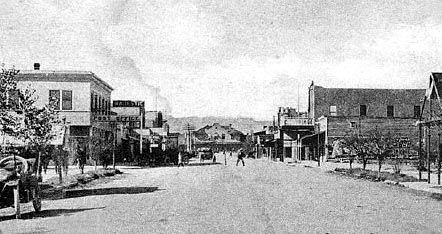
Las Vegas, Nevada, in 1918.
by Anthony Dee Varrone
To hundreds of old-timers, he was a distinct character. One of those individuals who stand apart as somewhat of an institution for Sam Gay’s history in the first quarter of the 20th century was the history of Clark County and the city of Las Vegas, Nevada. For years, Gay was the lone peace officer in that part of the country. Those were the days of the open saloon when Las Vegas was a community typical of the Wild West and proud of it. In those days, an officer’s life was one of constant danger and constantly shifting but troublesome problems which had to be met, usually in the twinkle of an eye, if the officer was to survive.
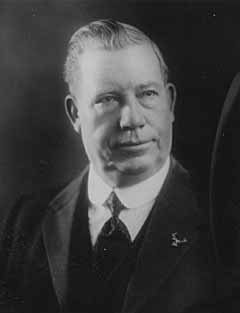
Sam Gay
Little is known about Sam Gay before he came to Las Vegas. He claimed to have been born on March 1, 1860, on Prince Edward Island and raised in Boston, MA. His first job of record was as a driver on the San Diego, California, mule-drawn streetcar system in the early 1900s. News of another gold rush found “Big Sam” headed for Goldfield, Nevada, but he got as far as Las Vegas, where he promptly drank up all of his money. To refinance himself, Sam took a job few wanted and which even fewer could hold: Bouncer on the notorious Block 16, which in the early years was the only area where liquor was served without licensing restrictions, and prostitution flourished. Euphemistically hired as a “night watchman,” he was paid by saloon keepers to keep order on the line.
Sam was a huge, muscular man, standing 6’5″ and weighing 260 pounds. Unbeatable in a barroom brawl, it was claimed he once was matched to fight John L. Sullivan in Boston, but promoters ran into financial trouble and called off the match. His size was sufficient to quiet most altercations without a blow being struck. On occasions when two or more drunken brawlers tried to gang up on him, Sam took them on a pair at a time, seizing them by their necks and cracking their heads together. Once when a crazed caballero rushed him with a knife, Sam picked the man up by the shoulders and shook him into insensibility. Then he took the inert form outside under one arm and tied him to a hitching post. The next morning, when the fellow sobered up, Sam turned him loose.
Affable and impressive, Sam entered politics in 1906, running for City Constable in the first election in Las Vegas as a Lincoln County township, defeating the incumbent who had been appointed a year before. In 1908, he was appointed deputy under Lincoln County Sheriff Paul K. Smith until 1909, when Clark County was established with Las Vegas as its seat.
One strange case Sam investigated early in his career was reported by journalist Elton Garrett in ‘The Las Vegas Review‘:
“…five corpses, bloodstained and battered, lay on the floor pretty much as they had fallen. It was not an ordinary saloon in which this free-for-all battle, resulting in the indiscriminate slashing, shooting, and butchers, had transpired. It was an unusual saloon, a little isolated joint off in the sticks, back of the railroad roundhouse, and patronized by… hard men. Men who often drank their whisky without chasers, carried cannons in their shirt fronts and knives in their boots. Gunplay was not unusual, but this was a wholesale brawl…
“Sam Gay, deputy sheriff and coroner, was the only Las Vegas servant of a county which then was scarcely able to pay its officers… The deputy felt keenly his responsibility to the people whom he represented. So he set about solving the mystery of who killed the five Mexicans.
“After ordering all present to take a seat, with a warning not to leave, he questioned the scowling denizens, but in the end, Sam had little more information than when he arrived.
“Well, it looks like there was a general brawl here this evening and five of the brawlers got theirs, the deputy/coroner said at last, “If I can’t find out from any of you fellows who else was here and who started this mess, then I don’t know who will tell. It’s a cinch they won’t tell,” he said, with a wave at the corpses.
“Sam examined the premises, noted the details, and then had the bodies removed, and he saw to it that they were all given respectable burials. He doggedly continued investigating over the next several days, but all he could learn was that the men were having a general good time and that, somehow some of them got started arguing and threatening one another. This was soon followed by the stabbing of bodies and the shooting of pistols.”
Almost a month later, Sam received a wire from the Lincoln County sheriff asking about the shooting. The story goes that Gay sent a return wire with this his full report:
“Five mexicans killed. Brawl. All buried. No expense to county. Signed, Gay.'”
In the early days, Sam’s jail was the city lock-up; the calaboose, located on First Street, just North of Block 16. His “office” was a desk in the corner of the town hall which he shared with the library.
The easygoing lawman didn’t make many arrests; serious crime was rare then, and most petty infractions were settled with a minimum of trouble by the big deputy.
Sam’s friends thought he should have been the first sheriff when Clark County was formed in 1909. However, Charles Corkhill, a Democrat and former editor of the Las Vegas Age was given the appointment from the commissioners who had been named by the governor.
Sam stayed as Corkhill’s deputy for a few months, but it became obvious that the public had come to embrace the younger man, causing the sheriff to seek a reason to fire him.
One hot day in 1910, Sam saw that the prisoners in his lock-up, which was constructed of sheet metal and railroad ties, were suffering in 120-degree heat inside. Alarmed by the deadly potential of the situation, and despite his boss’s orders, he chained together the sweaty group of men, marched them down to the old Las Vegas Ranch, and chained them to a cottonwood tree by the creek bank.
Sam was fired on the spot by a furious Corkhill.
The following year when the appointed county officers were required to stand for election, Sam filed on the Republican ticket against Corkhill and whipped him easily. It was the Democrats’ year at the polls, and Sam was among the few Republicans elected in Nevada. If he had only one claim to fame, it was that, although he was a Republican, he managed to hold his job as sheriff for twenty years, against all Democratic comers, in a Democratic county. Voters used to ride hundreds of miles to cast their ballots for him every election.
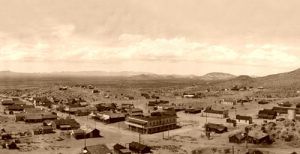
Searchlight, Nevada, 1910
Two or three times a year, Sam hitched up his buckboard and visited the outlying county precincts at El Dorado Canyon, Searchlight, Goodsprings, and Moapa and Virgin Valleys. Otherwise, with a deputy to do all the administrative work, Sam spent his time on Fremont Street where, he rightfully figured, in a month’s time, everybody in the county would pass, sooner or later. And when they passed down the main drag, Sam was there to spend a pleasant hour chewing the fat.
As the sheriff continued to be much beloved by the citizenry, he also garnered powerful enemies – “The Courthouse Ring,” he called them. His primary antagonist was Judge Charles Lee Horsey. By 1914, the feud was so heated that the judge ordered a bench warrant for Sam’s arrest after Sam took his sweet time arriving when summoned to the judge’s office. Sam’s deputy, Ray Lockett, was given the duty of executing the warrant on his boss. Sam, while outraged at first, decided to go along peacefully, particularly since Lockett was marching him to court a the point of a gun. The matter was quickly handled, and Sam was freed. He then fired Lockett and never forgave Judge Horsey for being the catalyst.
Sam then hired Joe Keate as his deputy, for Joe was well-known all over the county, was loyal to Sam, and willing to carry out the sheriff’s orders, which did not include marching the boss to court at gunpoint.
More and more, Sam was having difficulty with District Attorney A.S. “Bart” Henderson, who had been elected in 1914 and promptly took his place with the anti-Sam Gay faction. Former deputy Lockett filed to run for sheriff in 1916. One month before the election, Deputy Keate got involved in a scandal when he was charged with permitting a game of stud poker to progress in violation of a state law passed in 1909 that made gambling illegal.
Henderson filed charges against the seven gamblers in the game and established that Keate had not only permitted them to play but sat in on a few hands himself. Sam was forced to remove his deputy from office. Sam won the election by a margin of more than 2-1. The following day he reinstated Keate as deputy, a move which clearly showed his feelings about the D.A.’s action against gamblers.
The courthouse feud became hotter with every incident, and matters weren’t helped when Keate and Justice of the Peace Bob Harkins developed a grudge against one another.
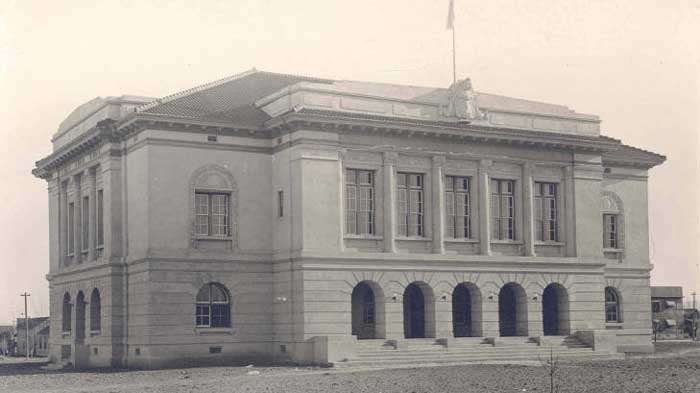
Clark County Courthouse, early 1900s. UNLV Digital Collection.
In the Summer of 1917, with a Justice court trial in progress, Keate was directed to bring in a witness. He dallied on the street corner for an hour before returning, and Harkins fined him five dollars for contempt of court. Enraged, Keate went out and got another gun. While the trial was in progress, he interrupted the proceedings by tossing the weapon to Harkins with the challenge to defend himself.
D.A. Henderson, the prosecutor, attempted to interfere, but Keate leveled his gun at Henderson’s middle and ordered him to keep out of the argument. Sam was standing by, watching the show, when Henderson demanded that he arrest his deputy. The sheriff ignored the demand and, after a tense moment, took his deputy by the arm, and they departed.
Henderson appeared before Judge Horsey the following day and charged Sam with “nonfeasance of office,” requesting his removal. The court agreed, and Sam found himself stripped of office.
The election of 1918 was the bitterest of Sam’s career, complete with lots of mud-slinging and rumor-mongering. Sam also took time to speak for Henderson’s opponent, A.J. Stebenne, even though he hardly knew the man.
The election was a landslide for Sam Gay, and as a side benefit, Henderson was defeated by the relatively unknown Stebenne, based on the backing of Sam Gay.
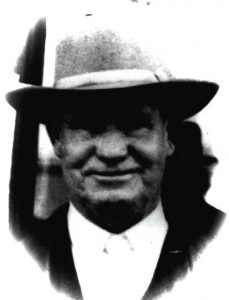
Sam Gay
Sam announced his retirement in 1930 and could not be coaxed to run for office again. As he explained it himself: “I’m used to tough hombres who shot each other up once in a while. I’m used to gunfights. But I ain’t much good running down racketeers. My notions is too old-fashioned. You can’t deal with these new gunmen with a single-action .45. Need a machine gun. I’m too old to learn to run one, so I quit.”
He was comfortably well-off, and besides, the little town was changing. There were too many unfamiliar faces now on Fremont street, and Sam couldn’t trust strangers to “vote right.”
Three of his former deputies filed for office to succeed him, with Keate winning the election.
Few in Las Vegas could remember when anyone but Sam Gay was Clark County sheriff. By 1932, Sam’s retirement and advancing age mellowed most of the bitterness from his heart. He spent the early Summer looking up some of his old enemies, like Ed Clark and Judge Horsey, to shake hands and make peace.
The old lawman took a trip to California in August. While there, he had over-exerted himself running for a streetcar. Upon his return, he was ordered to the Las Vegas Hospital for rest and observation. He had been there a week when a sudden heart attack claimed his life at 6:39 am, August 24, 1932, at age 72.
Three days later, on a Saturday afternoon, services were held at the Elks lodge. Sam’s friends from all over the region gathered to pay their last respects. No place in town was big enough to hold them all, so services were held on the courthouse lawn beneath the shade trees that Sam had helped to plant almost 20 years before.
Since Sam’s death, many legends developed around him. Those who knew him idolized him. Those who elected him time after time would tell you that Sam Gay could do no wrong. Those who didn’t may, indeed, know better.
Yet all must willingly bestow upon him the distinction of being one of the few Republicans in Democratic Nevada to never lose an election, having been the most popular public servant of his day.
© Anthony Dee Varrone, submitted October 2020, previously published in the Las Vegas Municipal Court employees newsletter, as part of “The Tales of Vegas Vic” by A.D. Varrone. Updated November 2022.

Anthony Dee Varrone
About the Author: Anthony Dee Varrone is a born and bred Las Vegas Native. A retired court officer for the Las Vegas Municipal Court, Varrone is an avid Old West buff with a special interest in the early days of his hometown.
Also See:
Helen J. Stewart: First Lady Of Las Vegas
Las Vegas, Nevada – Sin City, USA

